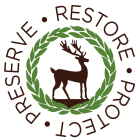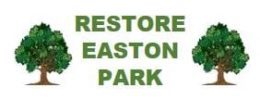THE HISTORY OF EASTON PARK
The village of Little Easton can be traced back to Roman times and was documented in the Domesday book as “Estaines Parva”.
On high ground and benefitting from multiple springs, it was a natural location for a settlement in the great forests of Essex which stretched from London to Thaxted. These forests were highly prized in Tudor times for deer hunting and frequently used by royalty.
Epping Forest and Hatfield Forest remain as prime examples and deer are still very much in evidence across Easton Park to this day.
Three outbreaks of the plague in 1348, 1361 and 1369 account for the fact that the main part of the village now lies a mile to the north of the Norman Grade I listed church built on the site of a Saxon church and the Manor House. Villagers with the plague moved away from the village to be apart from the rest of the community. The “Social Distancing” of its day!
Easton Park – The Jewel in the Crown
1302-1589
The documented history of Easton Park, one of the great parks of Essex, dates back over 700 years to 1302 when Matthew de Loveyn acquired a license for two deer parks at Little Easton.
From 1365 the Manor of Estaines and the estates surrounding Little Easton were owned by the Bourchier family. In 1527 Anne Bourchier married William Parr, the brother of Henry VIII’s sixth wife, Catherine Parr. The marriage ended in divorce, but William retained the lands and was made Earl of Essex in 1543.
In 1553, he was condemned to death for espousing the cause of Lady Jane Grey. Although William survived, he lost his lands which were later given to the church in 1558, the year Elizabeth I ascended the throne.
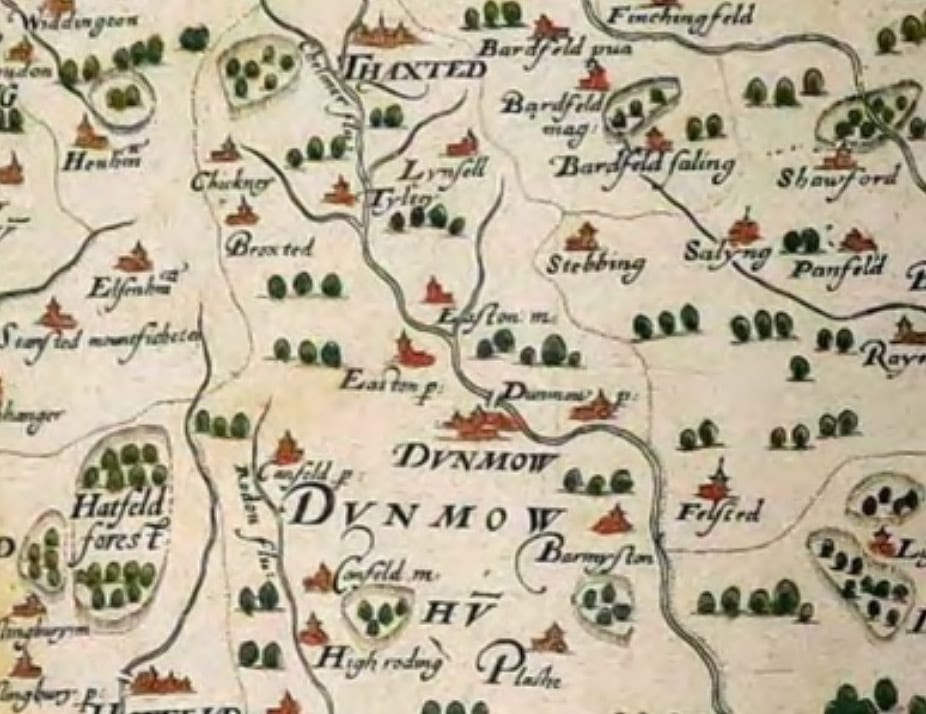
Little Easton from Christopher Saxtons – Map of Essex 1579
1590 - 1864
In 1590, Elizabeth I granted the Manor of Estaines and surrounding lands to Henry Maynard in recognition of his services to her chief adviser, Lord William Burghley. Knighted in 1603, Sir Henry became a substantial landowner.
Prior to the grant of the land at Little Easton, he acquired the Tilty Abbey lands in 1588, and subsequently added the Manor of Great Easton to his estate in 1597, and Little Canfield Hall before his death in 1610. In 1597, Sir Henry built an Elizabethan mansion at Easton Lodge but retained the name to reflect its origin as a hunting lodge.
Sir Henry’s son William inherited at least 10,000 acres of land in Essex from his father. He was made a Baron in 1620 and extended the estate with the acquisition of Great Canfield Lodge. His Grandson, also William, who succeeded in 1640, expanded the Park to its current shape and restored it as a functioning deer park. The enclosed Easton Park can clearly be seen on John Warburton’s 1724 map of the area. [1]
[1] British Library online maps: www.bl.uk/onlinegallery/onlineex/maps
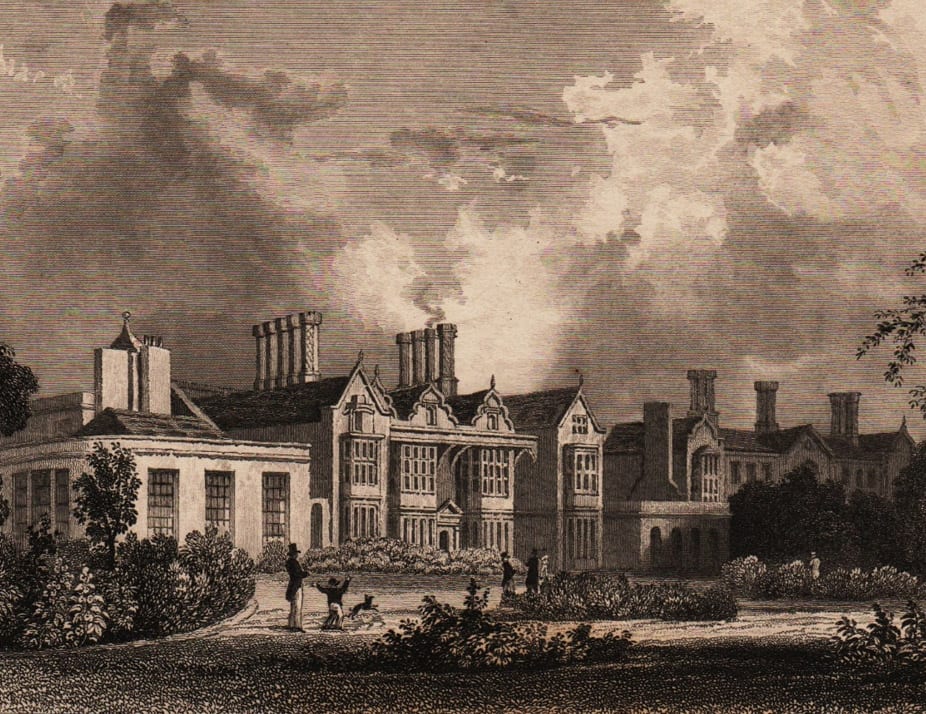
In 1597, Sir Henry built an Elizabethan mansion at Easton Lodge but retained the name to reflect its origin as a hunting lodge.
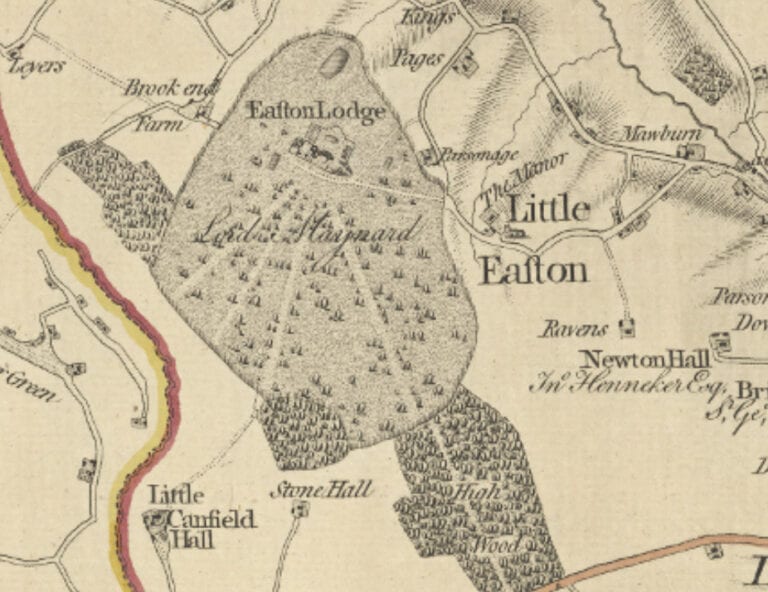
Little Easton from J Chapman and Peter André’s Map of Essex 1777. Easton Lodge shown with an enclosed park in the possession of Lord Maynard.
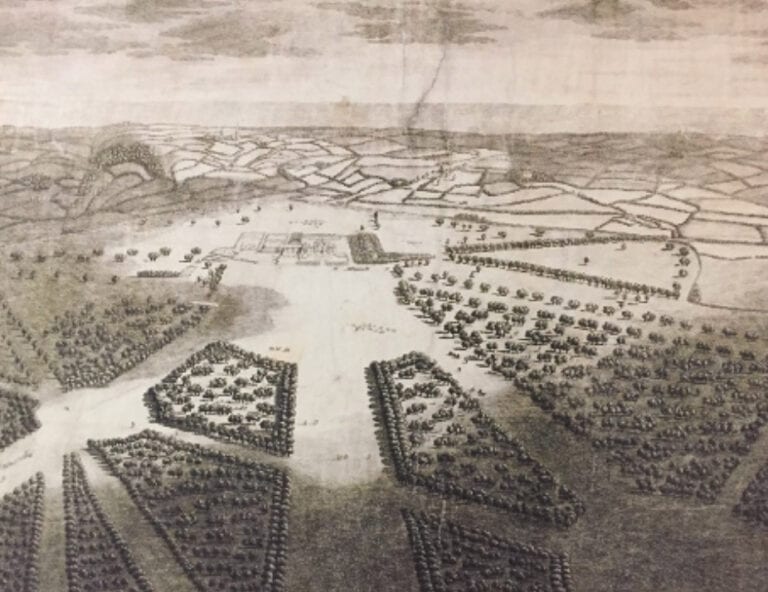
The former mansion of Easton Lodge set within Easton Park. This bird’s-eye view Skynner engraving of 1756 shows the earlier house within the setting of the grounds of the historic Easton Park.
The engraving shows the free-standing trees in the extensive areas of wood pasture set out as a “Patte D’oie” (Goosefoot) formation.
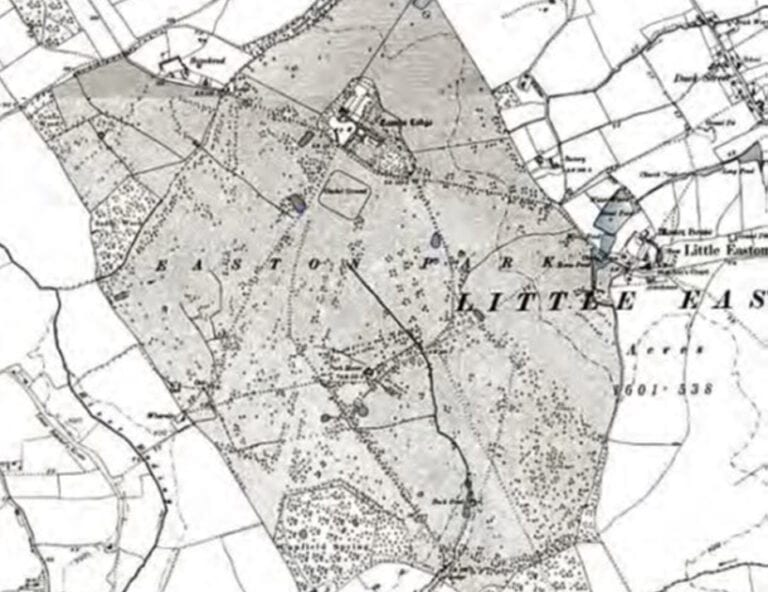
Easton Park Map of 1898 showing the layout of the enclosed park
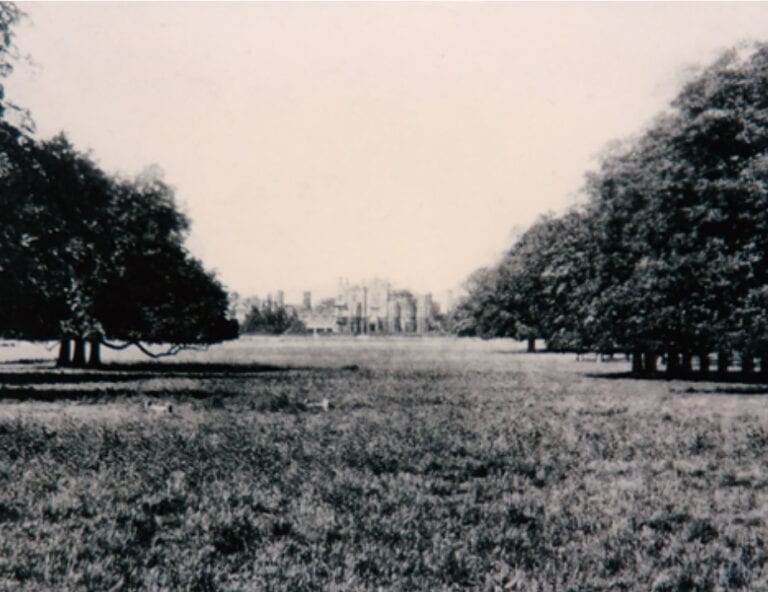
Over 300 years ago, the Tudor estate was redeveloped as Easton Lodge, with an enclosed park to the west of Little Easton.
In line with the fashion of the times, parkland in front of the lodge was laid out as four formal avenues of trees radiating out from a central point, in the manner of a “goose-foot” or “Patte D’oie”. These avenues can be seen in the 1777 Chapman & André map, and in a Skynner engraving of 1756; They remained partly visible until 1940.
The Elizabethan mansion survived until a disastrous fire in 1847 following which Easton Lodge was rebuilt in the Victorian Gothic style to the designs of Thomas Hopper.
The expansion of the estate continued until the death of the last Viscount Maynard in 1865 by when it comprised some 14,000 acres mostly between Great Dunmow and Thaxted. The Maynard emblem in the form of either a deer or the letter ‘M’ in a round circle is still visible on many buildings in the area.

The Maynard emblem which can still be seen on many properties at Easton Lodge and in Little Easton and the surrounding villages which formed part of the Easton Lodge Estate.
1865 - 1939
Easton Lodge Estate reached its zenith under the ownership of Frances Evelyn ‘Daisy’ Maynard, who later became the Countess of Warwick.
Born in 1861, Daisy inherited the estate in 1865, at the age of three, following the death first of her father and soon after her grandfather. Daisy reputedly became the richest heiress in the country and in 1881 married Francis Greville, who in 1893 became the 5th Earl of Warwick on the death of his father.
The Countess was a colourful individual with many gifts including intelligence, beauty, social skills and considerable abilities as a writer, gardener and farmer. She entertained extensively with notable invitees being the Marlborough Set, resulting in a close relationship for nine years from 1886 with the Prince of Wales who became Edward VII in 1901.
In 1902 the Countess commissioned Harold Peto to improve her gardens including building an Italian sunken garden to the north of Easton Lodge. His creations are the only ones to be found in East Anglia. The Countess also renovated Stone Hall, a property to the south of the Park, where she created a themed garden in the Arts and Crafts style which was the subject of considerable acclaim.
As the Countess of Warwick, “Darling Daisy”, as she became affectionately known, entertained lavishly at Easton Lodge, where the Prince of Wales (who was crowned King Edward VII in 1901) was a frequent guest. A train halt was built on the line at Little Canfield for visitors to Easton Lodge.
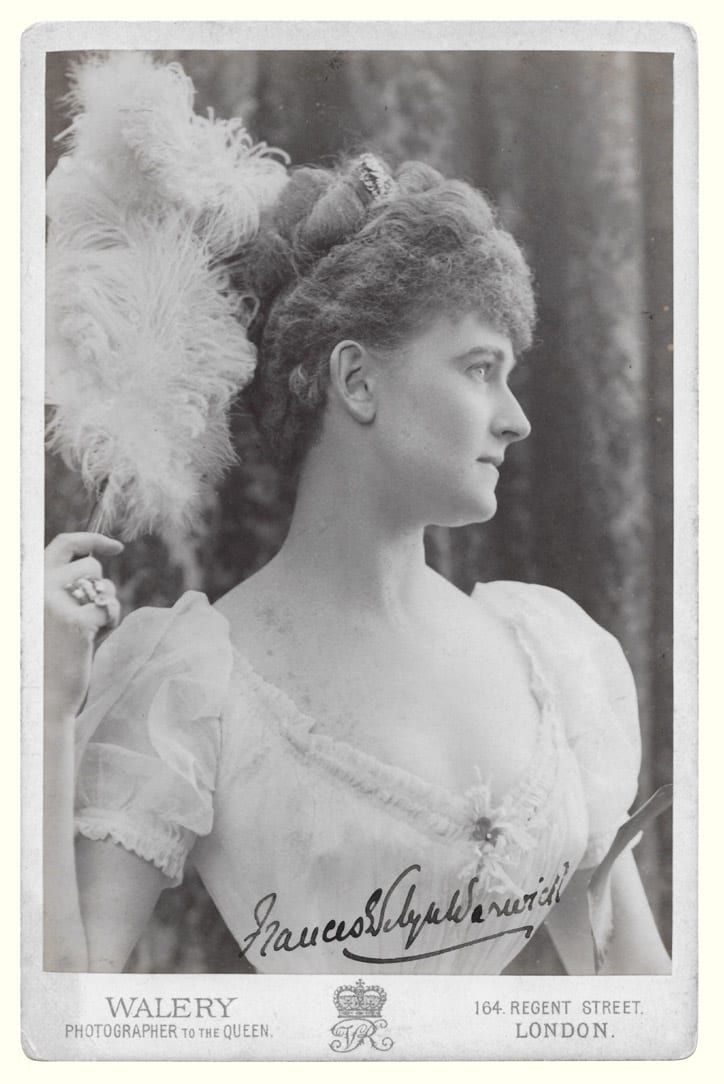
In 1895, following left-wing press criticism of an extravagant ball at Warwick Castle, the Countess became a Socialist and thereafter played an active role in many progressive causes, notably the welfare of the local community with particular emphasis on educational reform and employment skills, especially for women. In the 1923 General Election, the Countess stood as the Labour Party candidate for the Warwick and Leamington constituency. She was beaten by Anthony Eden, the Conservative candidate, and future Prime Minister.
In 1909, the writer HG Wells became a tenant at the Rectory renaming it Easton Glebe where he remained until 1928 following the death of his wife, Jane. He too entertained extensively including many of the well-known writers of his day, such as George Bernard Shaw, Rebecca West and Charlie Chaplin. Wells’s semi-autobiographical novel Mr. Britling Sees It Through, published in 1916, provides many thinly veiled depictions of local places and people – the village of Matching’s Easy corresponds to Little Easton, ‘Claverings’ to Easton Lodge, and Lady Homartyn to the Countess. There is a particularly evocative description of the annual Flower Show at Claverings in the summer of 1914.
The Countess had a keen interest in theatre partly through a close friendship with the acclaimed actress, Ellen Terry who was a regular visitor. She converted the barn at Little Easton Manor to create a theatre where many notables including HG Wells and George Bernard Shaw performed. Following the marriage of her daughter Mercy to the theatre impresario Basil Dean in 1925, the Countess sold them the Manor where Dean carried out substantial renovations in the art deco style.
Financial pressures arose, due to the Countess’s extravagant expenditure and problems in the agricultural sector, which lead to major land and property sales in 1919 and 1921 and a significant reduction in the estate. Despite the changes to her circumstances, the Countess continued to live at Easton Lodge, where she became increasingly interested in animal welfare and the natural world. She looked after a varied collection of animals and birds at Easton, including cats, dogs, monkeys, and a group of retired circus ponies.
In 1937, the Countess of Warwick declared the Park a nature reserve and put in train an agreement with The Rural District Council of Dunmow to limit development on the Park to no more than ten dwellings. The agreement was signed in 1939, after her death, by her executors and remains in force to this day.
The Countess died in 1938 and was succeeded by her son, Maynard Greville.
1939-1945 - THE WAR YEARS
The War Office requisitioned both the house and the Easton Lodge Estate Park at the start of the war, and an airfield was built during 1942 to 1943 where the USAAF 386th Bomber Group, the Crusaders, were based from 1943 to 1944.
The Park was cleared to build the airfield with the destruction of 10,000 trees across the estate.
The USAAF 386th Bomber Group, flying B26 Marauders, were heavily involved in the bombing of Utah Beach prior to the D Day landings in June 1944. The 386th then moved to France and were replaced by RAF 190 and 620 Squadrons flying Mk IV Stirlings modified to tow troop-carrying gliders. In March 1945 they were involved in the crossing of the Rhine as part of “Operation Varsity”.
After VE Day, the Park became an army storage depot for more than 34,000 vehicles.
Aerial photograph of RAF Great Dunmow aerodrome in May 1944. Easton Lodge with Peto’s gardens is clearly visible top centre of the photograph.
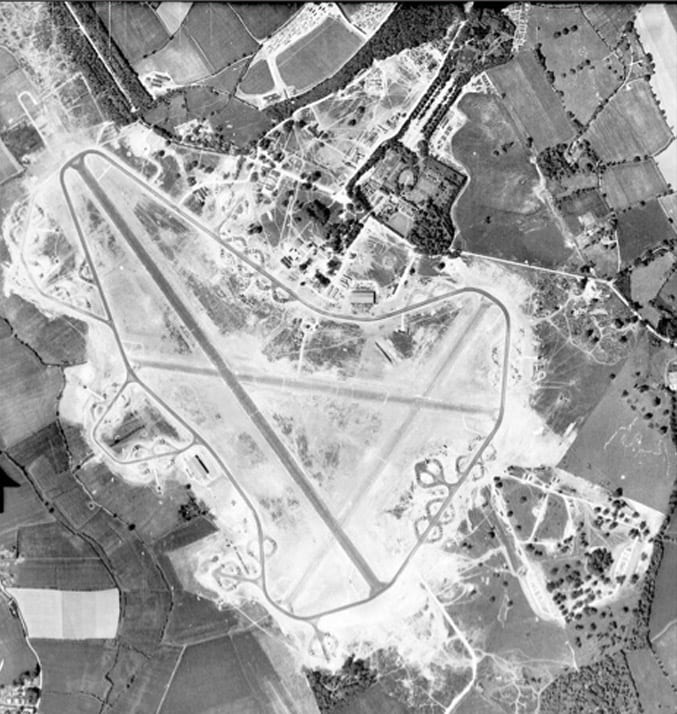

The north chapel of the Little Easton Church of St Mary the Virgin (in the Little Easton Conservation Area adjoining Easton Park) is dedicated to the USAAF 386th Bombardment Group known as The Crusaders.
This was the first airfield visited by General Eisenhower on his USAAF airfield tour on the 11th April 1944.
The estate was returned to the Maynard family in 1950 when the badly damaged house was pulled down, leaving only the west wing, and Easton Park was converted to agricultural use.
EASTON PARK TODAY

The land surrounding Easton Lodge and Easton Park amounting to some 2,400 acres was retained by the descendants of the Maynard family until 1,619 acres were sold to Land Securities in 2004.
The extent of Landsec’s land holdings can be seen in the map (land bordered in red is now owned by Landsec – Land shaded red is the historic Easton Park).
The core of the park, comprising some 1,150 acres retains its original shape which is clearly visible to this day, as too the vibrant wildlife of deer, birds, flora and fauna that the Countess was so determined to protect for future generations.
The Gardens of Easton Lodge are now listed as a Grade II Registered Park and Garden following a major restoration started in the 1970’s.
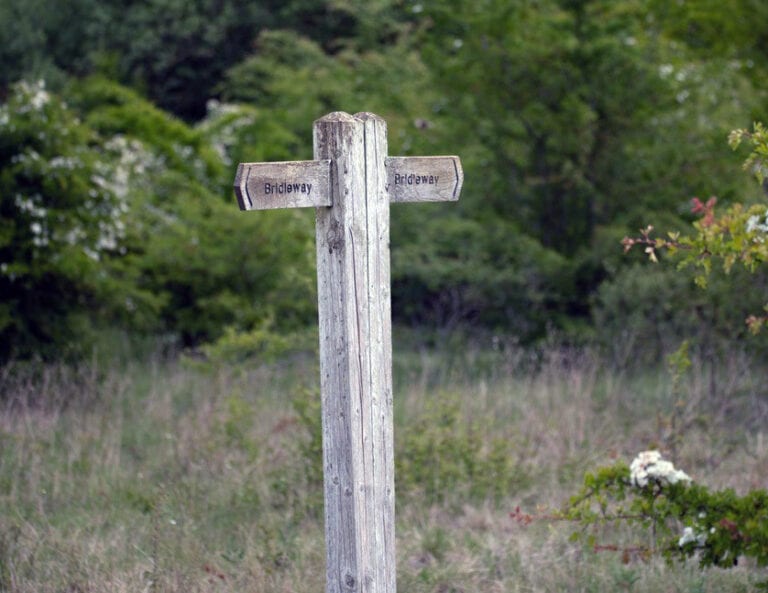
The Park is crossed by multiple by-ways and footpaths and sits at the centre of a group of related assets including High Wood, an SSSI, to the south, The Grade II* listed Stone Hall to the south east, the Lays Wood to the north east, the Grade II Registered Gardens of Easton Lodge to the north and the Little Easton Conservation Area surrounding the Grade I listed Norman church and Little Easton Manor to the north east. The area also includes an exceptional range of listed buildings most of which were formerly part of The Easton Lodge Estate and as such provides a rare insight into the form of a large country estate at the turn of the 19th/20th centuries.
In 1994, a proposal to build 2,500 dwellings on Easton Park was rejected by the Planning Inspector.
In 2017, Uttlesford District Council issued a draft Local Plan including a proposed allocation to build 10,000 dwellings at Easton Park but following concerns expressed by the Planning Inspectors in January 2020, the draft Plan was withdrawn on 30 April following a vote backed by an overwhelming majority of Councillors.
Easton Park is a key asset both for the district of Uttlesford and the county of Essex. Extensive building in recent years in the locality, notably Great Dunmow, Takeley and Bishop’s Stortford, has highlighted the need for a large open space, a destination park, to serve the needs of the local community. This need is most clearly demonstrated by the current plight of Hatfield Forest which is suffering severe degradation due to excessive use resulting from house building.
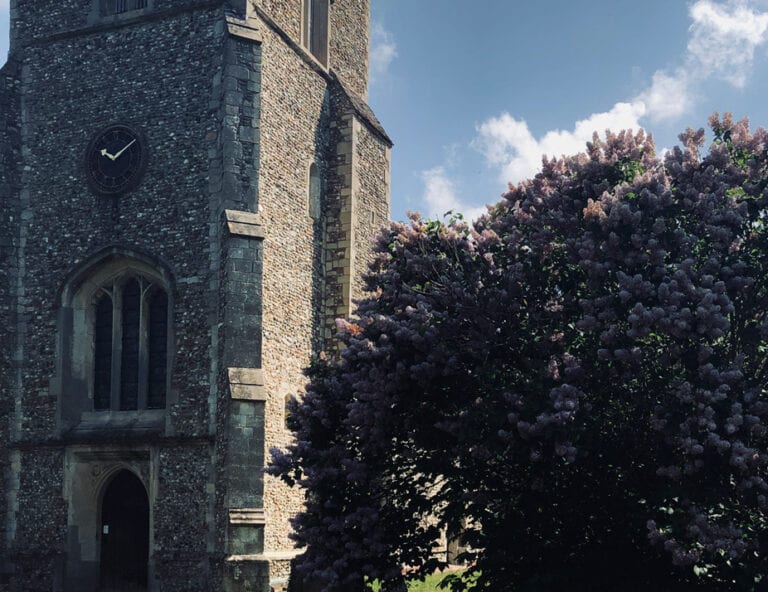
The Grade I listed Church of St Mary the Virgin within the Little Easton Conservation Area which borders the Eastern boundary of Easton Park.
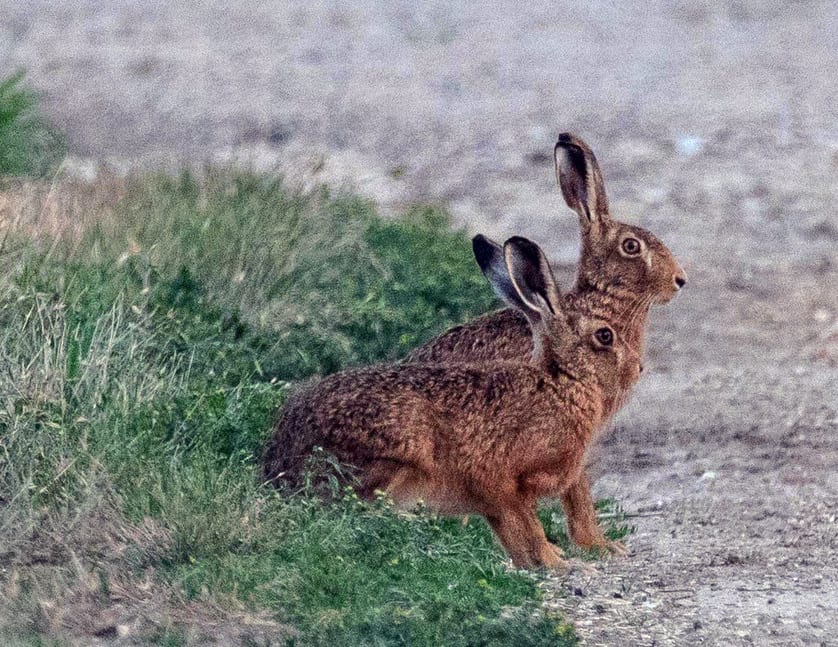
This campaign is designed to highlight the indisputable merits of Easton Park as an open space accessible to the general public given that it can never be seen as a suitable location for a new town, be it 10,000 dwellings or less, due to its lack of access to the M11 and the mainline railway, its proximity to Stansted Airport and Great Dunmow, its severely restricted access, resultant congestion and the severe impact on the ecosystem and heritage of this rare asset.
It is hoped that UDC will be persuaded to use its powers under the 1939 Agreement to protect the Park and work towards its restoration for the benefit of future generations.

